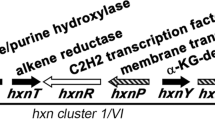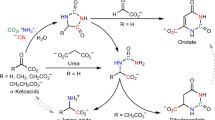Abstract
Fungi have evolved a unique α-amino-adipate pathway for lysine biosynthesis. The fungal-specific enzyme homoaconitate hydratase from this pathway is moderately similar to the aconitase-family proteins from a diverse array of taxonomic groups, which have varying modes of obtaining lysine. We have used the similarity of homoaconitate hydratase to isopropylmalate isomerase (serving in leucine biosynthesis), aconitase (from the tricarboxylic acid cycle), and ironresponsive element binding proteins (cytosolic aconitase) from fungi and other eukaryotes, eubacteria, and archaea to evaluate possible evolutionary scenarios for the origin of this pathway. Refined sequence alignments show that aconitase active site residues are highly conserved in each of the enzymes, and intervening sequence sites are quite dissimilar. This pattern suggests strong purifying selection has acted to preserve the aconitase active site residues for a common catalytic mechanism; numerous other substitutions occur due to adaptive evolution or simply lack of functional constraint. We hypothesize that the similarities are the remnants of an ancestral gene duplication, which may not have occurred within the fungal lineage. Maximum likelihood, neighbor joining, and maximum parsimony phylogenetic comparisons show that the a-aminoadipate pathway enzyme is an outgroup to all aconitase family proteins for which sequence is currently available.
Similar content being viewed by others
References
Altschul SF, Gish W, Miller W, Myers EW, Lipman DJ (1990) Basic local alignment search tool. J Mol Biol 215:403–110
Bakhiet N, Forney FW, Stahly DP, Daniels L (1984) Lysine biosynthesis in Methanobacterium thermoautotrophicum is by the diaminopimelic acid pathway. Curr Microbiol 10:195–198
Bhattacharjee JK (1992) Evolution of the a-aminoadipate pathway for the synthesis of lysine in fungi. In: Mortlock RP (ed) The Evolution of metabolic function. CRC Press, London
Bruns RD, Vilgalys R, Barns SM, Gonzalez D, Hibbett DS, Lane DJ, Simon L, Stickel S, Szaro TM, Weisburg WG, Sogin ML (1992) Evolutionary relationships within the fungi: analyses of nuclear small subunit rRNA sequences. Mol Phylo Evol 1:231–241
Bult CJ, White O, Olsen GJ, Zhou L, Fleischmann RD, Sutton GG, Blake JA, FitzGerald LM, Clayton RA, Gocayne JD, Kerlavage AR, Dougherty BA, Tomb J-F, Adams MD, Reich CI, Overbeek R, Kirkness EF, Weinstock KG, Merrick JM, Glodek A, Scott JL, Geoghagen NSM, Weidman JF, Fuhrmann JL, Presley EA, Nguyen D, Utterback TR, Kelley JM, Peterson JD, Sadow PW, Hanna MC, Cotton MD, Hurst MA, Roberts KM, Kaine BP, Borodovsky M, Klenk H-P, Fraser CM, Smith HO, Woese CR, Venter JC (1996) Complete genome sequence of the methanogenic archaeon, Metha- nococcus jannaschii. Science 273 (5278):1058–1073
Dayhoff MO, Schwartz RM, Orcutt BC (1978) A model of evolutionary change in proteins. In Dayhoff MO (ed) Atlas of protein sequence and structure, vol 5, suppl 3. Natl Biomed Res Found., Silver Spring, MD, pp 345–352
Felsenstein J (1993) PHYLIP (phylogeny inference package) version 3.572. Distributed by the author. Department of Genetics, University of Washington, Seattle, WA
Hentze MW, Argos P (1991) Homology between IRE-BP, a regulatory RNA-binding protein, aconitase, and isopropylmalate isomerase. Nucleic Acids Res 19:1739–1740
Jensen RA (1976) Enzyme recruitment in evolution of new function. Ann Rev Microbiol 30:409–25
Jones DT, Taylor WR, Thornton JM (1992) The rapid generation of mutation data matrices from protein sequences. Comput Appl Biosci 8:275–282
Kaptain S, Downey WE, Tang CK, Philpott C, Haile DJ, Orloff DG, Harford JB, Rouault TA, Klausner RD (1991) A regulated RNA binding protein also possesses aconitase activity. Proc Natl Acad Sci 88:10109–10113
Lauble H, Kennedy MC, Beinert H, Stout CD (1992) Crystal structures of aconitase with isocitrate and nitroisocitrate bound. Biochemistry 31:2735–2748
Margulis L (1996) Archeal-eubacterial mergers in the origin of Eukarya. Proc Natl Acad Sci USA 93:1071–1076
Page RDM (1996) TREEVIEW: an application to display phylogenetic trees on personal computers. Comput Appl Biosci 12:357–358
Robertson DE, Noll D, Roberts MF (1992) Free amino acid dynamics in marine methanogens. beta-Amino acids as compatible solutes. J Biol Chem 267:14893–14901
Saitou N, Nei M (1987) The neighbor-joining method: a new method for reconstructing phylogenetic trees. Mol Biol Evol 4:406–425
Schäfer S, Paalme T, Vilu R, Fuchs G (1989) 13C-NMR study of acetate assimilation in Thermoproteus neutrophilus. Eur J Biochem 186:695–700
Strassman M (1964) Lysine biosynthesis in yeast. Abstr 6th Intern Congr Biochem 5:373–374
Strassman M (1964) Lysine Biosynthesis in yeast. Abstr 6th Intern Congr Biochem 5:373–374
Strassman M, Ceci LN (1966) Enzymatic formation of cishomoaconitic acid, an intermediate in lysine biosynthesis in yeast. J Biol Chem 241:5401–5407
Strassman M, Weinhouse S (1953) Biosynthetic pathways. III. The biosynthesis of lysine by Torulopsis utilis. J Am Chem Soc 75: 1680–1684
Strimmer K, von Haeseler A (1996) Quartet puzzling: a quartet maximum likelihood method for reconstructing tree topologies. Mol Biol Evol 13:964–969
Swofford DL (1993) PAUP, Version 3.1. Illinois Natural History Survey, Champaign, IL
Thompson JD, Higgins DG, Gibson TJ (1994) CLUSTAL W: improving the sensitivity of progressive multiple sequence alignment through sequence weighting, positions-specific gap penalties and weight matrix choice. Nucleic Acids Res 22:4673–4680
Umbarger HE (1978) Amino acid biosynthesis and its regulation. Annu Rev Biochem 47:533–606
Van der Auwera G, De Baere R, Van de Peer Y, De Rijk P, Van der Broeck I, De Wächter R (1995) The phylogeny of the Hyphochytriomycota as deduced from ribosomal RNA sequences of the Hyphochytrium catenoides. Mol Biol Evol 12:671–678
Vogel HJ (1960) Two modes of lysine synthesis among lower fungi: evolutionary significance. Biochim Biophys Acta 41:172–174
Vogel HJ (1965) Lysine biosynthesis and evolution. In: V Bryson (ed) Evolving genes and proteins. Academic Press, New York, pp 25–40
Wang L, Okamoto S, Bhattacharjee JK (1989) Cloning and physical characterization of linked genes (LYS4, LYS15) of Saccharomyces cerevisiae. Curr Genet 16:7–12
Weidner G, Steffan B, Brakhage AA (1997) The Aspergillus nidulans lysF gene encodes homoaconitase, an enzyme involved in the fungus-specific lysine biosynthesis pathway. Mol Gen Genet 255:237- 247
Zheng L, Kennedy MC, Beinert H, Zalkin H (1992) Mutational analysis of active site residues in pig heart aconitase. J Biol Chem 267: 7895–7903
Author information
Authors and Affiliations
Rights and permissions
About this article
Cite this article
Irvin, S.D., Bhattacharjee, J.K. A unique fungal lysine biosynthesis enzyme shares a common ancestor with tricarboxylic acid cycle and leucine biosynthetic enzymes found in diverse organisms. J Mol Evol 46, 401–408 (1998). https://doi.org/10.1007/PL00006319
Received:
Issue Date:
DOI: https://doi.org/10.1007/PL00006319




